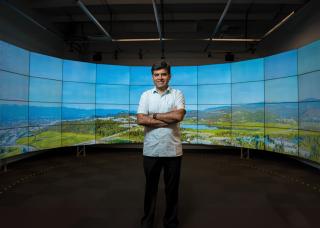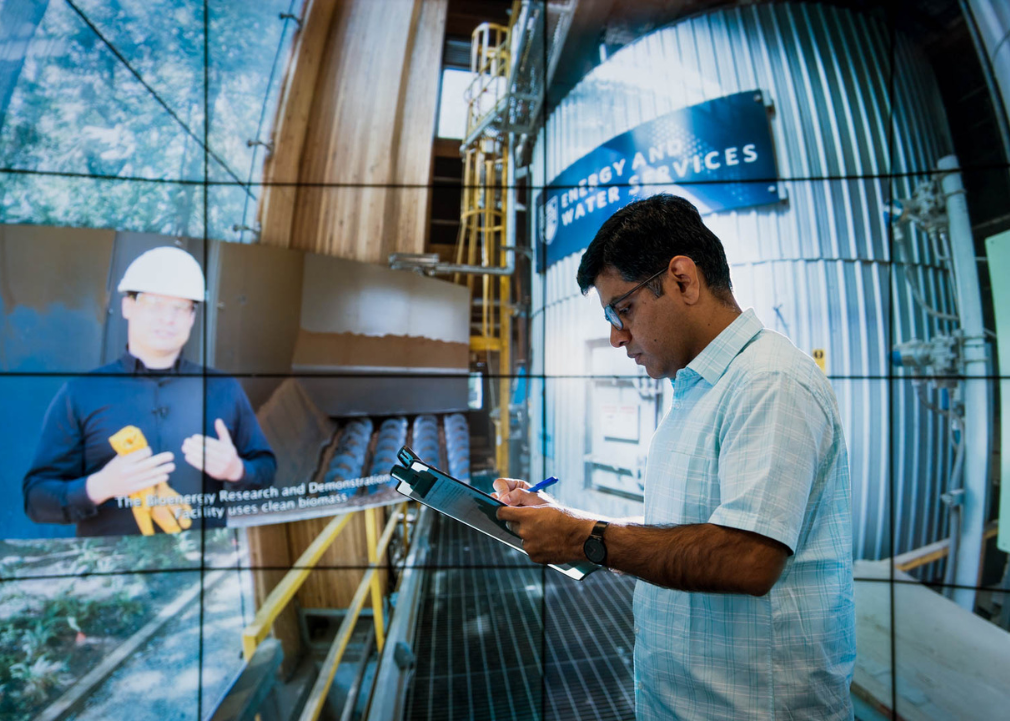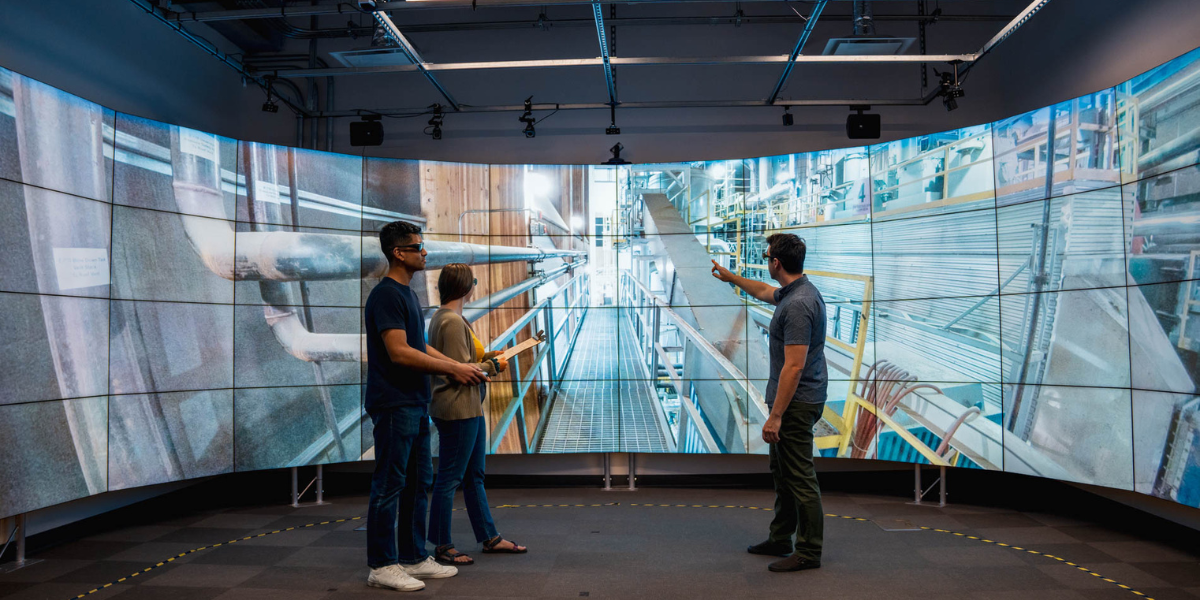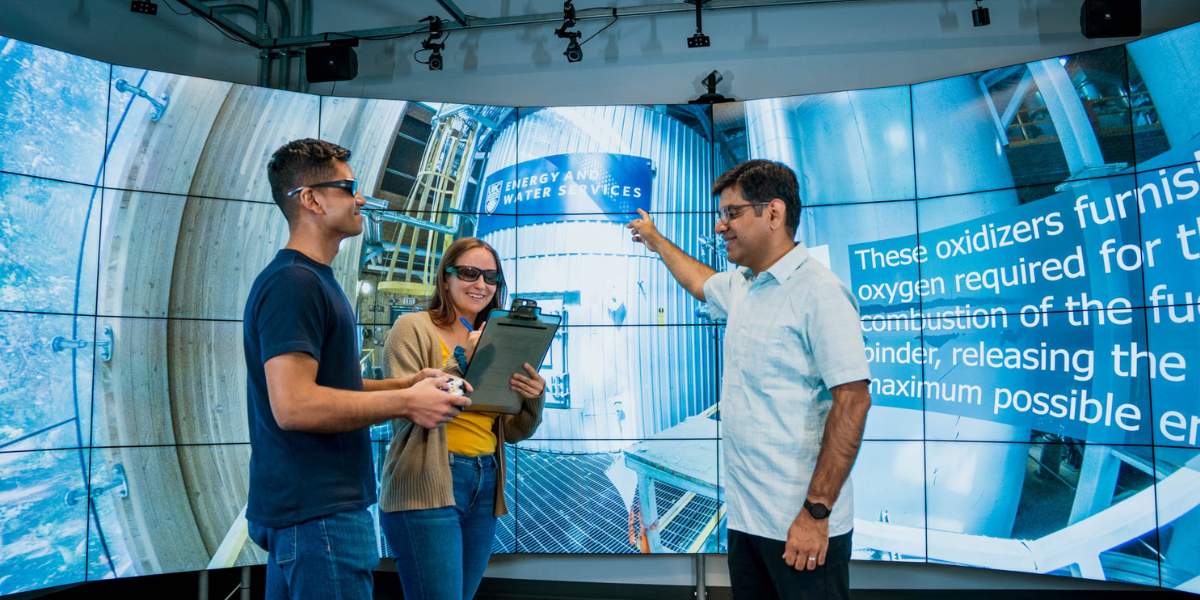When stars align to create immersive experiences for student learning
UBC Okanagan’s Dr. Vikas Menghwani is building a 3D virtual reality field trip to be integrated in sustainability and engineering courses

UBC Okanagan’s Dr. Vikas Menghwani is building a 3D virtual reality field trip to be integrated in sustainability and engineering courses

In spring of 2024, we asked our faculty and staff to tell us who among them were leading the way in generating positive change at the university. This is part three in a five-part series recognizing their efforts.
When Vikas Menghwani, Assistant Professor of Teaching in the Department of Earth, Environmental and Geographic Sciences, visited the International Space Station and looked upon Earth from space, he was overcome by a sense of awe and interconnectedness. But he didn't need to risk space travel for this transformative experience. Instead, Vikas witnessed our fragile blue planet floating in space at Space Explorers: The Infinite, the world’s largest immersive virtual reality (VR) exhibit – a life-changing experience that would pave the way for his future endeavours.

This profound experience sparked an idea: Vikas envisioned taking students on a one-of-a-kind field trip, integrating the benefits of in-person experiential learning with an immersive and interactive virtual reality tour. With this bold vision in place, he applied (and subsequently received funding) for the Aspire-2040 Learning Transformations Fund’s Constellation Protostar Fellowship Stream, which supports instructors looking to transform learning environments and experiences using emerging media.
Instead of using expensive headsets, Vikas’ virtual reality field trip is being created in collaboration with UBC Okanagan’s Constellation Spaces, utilizing Canada’s highest-resolution, 3D, VR-ready video wall at the Visualization and Emerging Media Studio (VEMS). By using the VEMS video wall, students will get a chance to ‘visit’ a bioenergy power plant situated 400 km away on the Vancouver campus. They will be able to experience the field trip as a group, navigate through the power plant at their own pace, and decide to engage with interactive components of the tour. With the help of 3D glasses and a controller, students can select pop-up videos of the Chief Engineer, find additional facts about the facility, or pause to participate in small discussions and group work – while staying on campus at UBC Okanagan.

This innovative project is now in progress, but it’s been a journey to get to this point.
When Vikas started teaching at the Vancouver campus in 2019, he organized field trips to the UBC Bioenergy Research Demonstration Facility. He knew from experience that learning outside the classroom provides opportunities for active engagement and inspires creativity and critical thinking when addressing real-world challenges. At different points in his career, Vikas had travelled extensively in India and Southeast Asia, as well as in remote Indigenous communities in Northern Canada, where he researched energy facilities and energy efficiency initiatives.
“One of the most crucial sustainability challenges is clean energy access and energy poverty,” Vikas explains. “Seeing the energy systems firsthand was a very meaningful experience – it helped me understand how developing and developed countries approach access to electricity.”
By observing these different approaches, Vikas discovered how various ways of accessing power could affect physical and economic sustainability. He became motivated to show students real-world energy systems, and the wood-fuel based bioenergy facility is an excellent case study in sustainability as well as energy management.
However, while planning for in-person field trips, Vikas discovered scheduling barriers – on one occasion, the main space was closed for repairs, and at another time, the host of the tour was not available. He knew that creating a virtual reality field trip would help overcome the logistical and resource challenges of planning and reduce the environmental impact of travel.
“Immersive virtual reality enhances learning with presence and agency. When you experience something in virtual reality, you are present mentally and you feel more in control,” Vikas explains. “It has the potential to make learners engage with the material at a more emotional level and remember the experience, and therefore, what they learned,” says Vikas.
It was nothing short of happenstance when – right after visiting the Space Explorers immersive exhibit – Vikas discovered the Emerging Media Lab at UBC Vancouver and he had a chance to ‘visit’ Stanley Park for the first time using a VR headset. He was amazed by the feeling of walking inside the park on a bright sunny day, even as he was physically located at the Vancouver campus on a dark and gloomy December evening.
Inspired by these VR experiences, Vikas continued to seek out emerging media at UBC Okanagan. “When I visited VEMS, I had a chance to see snippets of the immersive slideshow called Awful Splendour, which showed scenes from wildfires through the years,” he says. Using only 3D glasses, Vikas could witness the vivid post-wildfire landscapes on the VR-ready video wall.
That’s when the stars aligned. High-quality VR headsets can be expensive and need to be used one at a time – but taking students to the video wall for an immersive and interactive VR field trip enables active experiential learning in a classroom setting. “I knew this was meaningful and I realized the power of this technology and space that is unique to the Okanagan campus,” Vikas adds.
“Immersive virtual reality enhances learning with presence and agency. When you experience something in virtual reality, you are present mentally and you feel more in control.”
Dr. Vikas Menghwani, Assistant Professor of Teaching in the Department of Earth, Environmental and Geographic Sciences

Later this fall, Vikas will showcase the first-ever immersive 3D virtual reality field trip on the VEMS video wall, and bring students on a VR tour of UBC Vancouver’s Bioenergy Research Demonstration Facility. This VR experience will include customizable modules tailored for sustainability studies, environmental sciences, or engineering, and can be incorporated into a number of courses. There will also be a version for Canvas, to make this field trip accessible for individual learners on laptops.
This project aligns with Vikas’s broader interests in enhancing pedagogy through the productive use of educational technologies. “Technological advancements are inescapable, with huge implications for education. While some technologies can distract and shorten our attention spans, virtual reality has the potential to draw us in and fully capture our attention,” he explains.
As Vikas launches this immersive VR field trip for the new Bachelor of Sustainability program, he hopes his vision for this innovative pedagogical experiment will excite and engage his students – and be the first of many VR field trips using UBC Okanagan’s video wall technology.
Written by Alpha Lam, UBC Internal Communications
Interviewed in July 2024
Prescription for inclusive healthcare (Sept. 16)
Building a culture where learning and community can thrive (Sept. 23)
Mobilizing research, action, and communities to address climate change (Oct. 7)
Blending science and meditation to help students learn with a calm mind (Oct. 15)
Find the latest news, updates, events, and useful dates from across UBC, curated for faculty and staff by Internal Communications.
Access a library of resources from multiple UBC websites, all in one place.